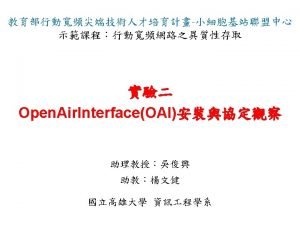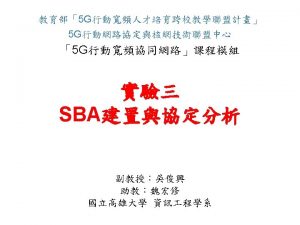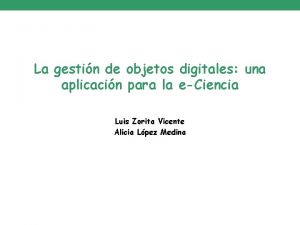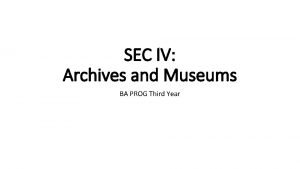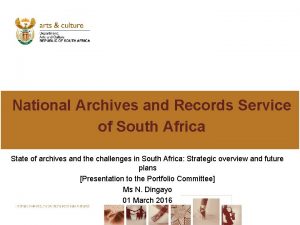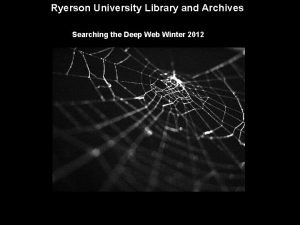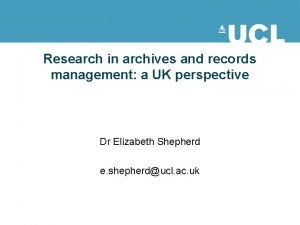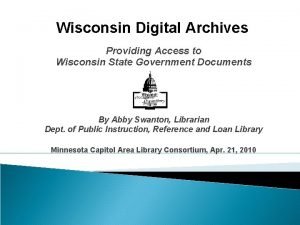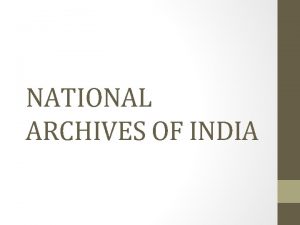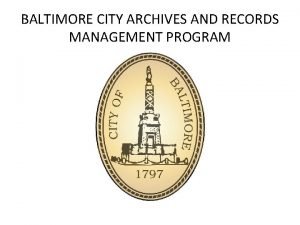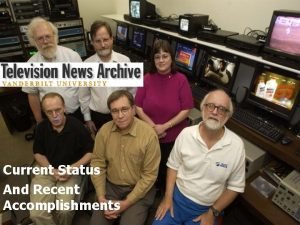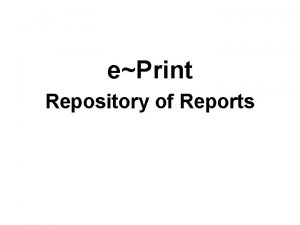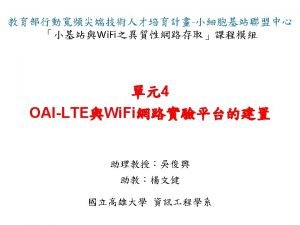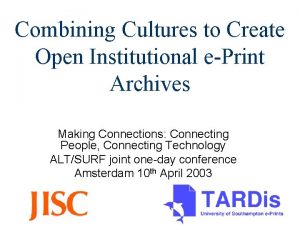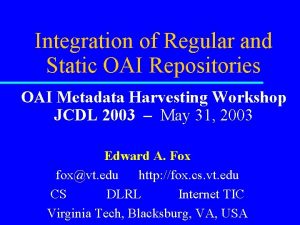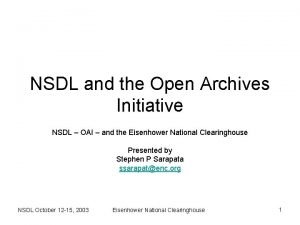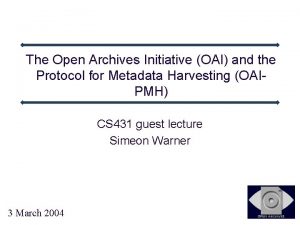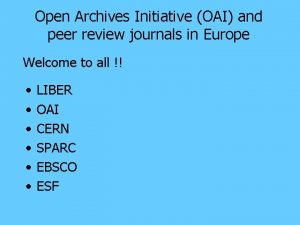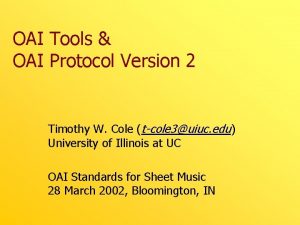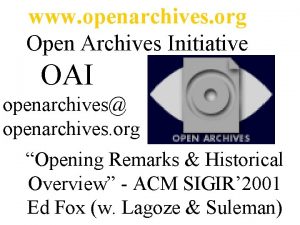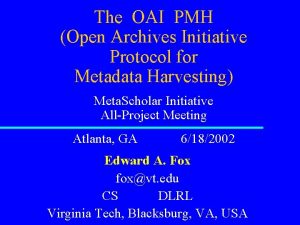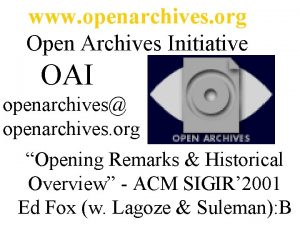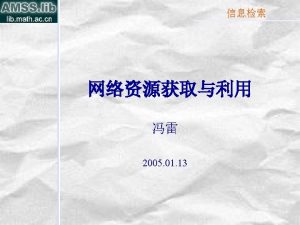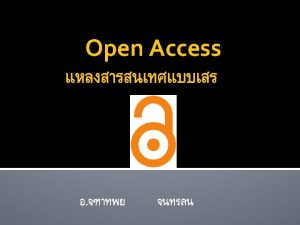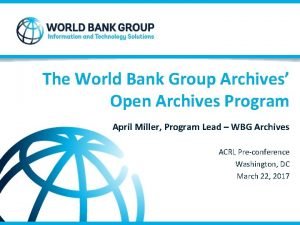From eprint archives to open archives and OAI





















- Slides: 21

From eprint archives to open archives and OAI: the Open Citation project By The Open Citation Project team Presented by Steve Hitchcock, Southampton University These slides prepared for the JISC/NSF Digital Libraries Initiative (DLI) All Projects Meeting, Edinburgh, 24 -25 th June 2002 Op. Cit is a joint JISC-NSF International Digital Libraries Project 1999 -2002

About this presentation The aim is to: • Report progress since Stratford All-Projects meeting in 2000 • Demonstrate new services developed by the project • Highlight the role of the project in the Open Archives Initiative • Outline key tasks remaining • Look beyond the Open Citation Project

Recap 1: principal partners • Southampton University, IAM (Intelligence, Agents, Multimedia) Research Group, PI Stevan Harnad Citation-ranked search, EPrints. org, user surveys • Cornell University, Digital Library Research Group, PI Carl Lagoze Architecture for reference linking, experiments with the ACM Digital Library and D-Lib magazine, OAI technical support center • ar. Xiv. org, Paul Ginsparg Now based at Cornell University. Still the largest archive of freely accessible author-deposited scientific papers

The Open Citation Project: deliverables The Open Citation Project (Op. Cit) is developing software and services to support the Open Archives Initiative (OAI). Op. Cit can help OAI data providers and service providers: • Citebase: citation-ranked search • EPrints. org software: free software to build and manage OAIcompliant eprint archives • API for reference linking, an interface on which reference linking applications can be built

Recap 2: last time at Stratford Reference links on pdf copies of papers

Citebase, a new interface to the scholarly literature

Citebase, a citation-ranked search engine http: //citebase. eprints. org/ “Google for the refereed literature” Citebase is based on a citation database • Harvests metadata using OAI-PMH • Extracts reference lists from ar. Xiv papers • Provides impact (and other)-ranked search based on reference data • Re-exports metadata + references

Evaluating Citebase http: //citebase. eprints. org/survey/ The evaluation is aimed at users of ar. Xiv, and all others who use bibliographic services to access the refereed journal literature. You can contribute (June-July 2002) using the form linked above. Aims of the evaluation: • Discover the user’s awareness of related services • Assess usability with a practical exercise • Invite the user’s views on the main features • Assess the level of user satisfaction with the service

Citebase: further developments • Open. URL-enabled: pointing Citebase links at library and journal services • Google interface using DP 9: getting Citebase results, and open archives, into Google • Metadata format and XML schema for citations: making citation metadata harvestable via OAI-PMH. Possible formats include: – Academic Metadata Format: a ‘local profile’ format, some collaborative experiments performed within Op. Cit – Open. URL metadata, moving towards NISO standardisation

Recap 3: API for reference linking get. Linked. Text – contents of the paper, reference-linked plus lots of metadata for the paper get. Reference. List – this paper’s references get. Current. Citation. List – the list of works citing this paper (best knowledge) get. My. Data – metadata for this paper

Surrogates in the API Based on an automatic analysis of the work, a surrogate for a scholarly work (and of other works, for citations), consists of the following three XML files: • Bibliographic data for the scholarly work • References contained in that work, and their contexts within the full text • Citations of that work

API evaluation API tested on D-Lib Magazine and the ACM Digital Library. Try demo at http: //cs-tr. cs. cornell. edu/Ref. Linking. Demo/ Performance (in terms of accuracy of data extracted): • Reference analysis: 86. 7% • Item analysis (bib data, contexts, and references for a given paper): 82. 42 % Implementability • Simple interface: Surrogate s = new Surrogate (some-url) • Portable: written in Java, has run in Solaris, Win 2 K, and NT 4 • Installation: API source code plus public domain jar files

EPrints. org software http: //www. eprints. org/ Generates eprint archives that are compliant with the Open Archives Initiative Protocol for Metadata Harvesting. EPrints is free (GPL) software. It is aimed at organisations and communities. EPrints v. 2. 0 released February 2002 (now on v. 2. 0. 1, which fixes bugs and typos). Features: • Internationalised metadata stored as Unicode • Support for multiple archives on one server • Improved user interface

Op. Cit and OAI • OAI Aggregator (‘Celestial’): collecting and caching the results from OAI data providers to improve the efficiency of data harvesting http: //celestial. eprints. org • OAI infrastructure: proxies, caches, gateways. Improve interoperability, scalability and reliability of OAI services. Joint work with Old Dominion University, see paper http: //arxiv. org/abs/cs. DL/0205071 • OAI Registration and Validation: performed at Cornell http: //www. openarchives. org/Register/Browse. Sites. pl

EPrints and OAI • EPrints feeds repository URLs straight into the OAI registration process (if so desired by the EPrints administrator) • A scan of the OAI database of registered sites shows many sites use EPrints software to create repositories

A repository administrator’s view of OAI “As we have introduced our repository to our faculty and staff, we have emphasized the point that because they would be depositing their material in an OAI-compliant archive, it would automatically and painlessly be discoverable from various other points around the globe. Luckily, we were right. ” Roy Tennant, e. Scholarship, California Digital Library, June 2002 http: //www. ecs. soton. ac. uk/~harnad/Hypermail/Amsci/2085. html

Op. Cit user surveys and data mining Maximising impact Maximising access Results from Mining the Social Life of an Eprint Archive http: //opcit. eprints. org/tdb 198/opcit/ When interoperability is not enough: show authors what users do when open access services are available

Key project tasks remaining Op. Cit formally ends in September 2002. Before then: • Evaluation and reporting of the results • Programmer's guide to using the API • Journal and conference papers • Final reports to JISC and NSF

Beyond Op. Cit Beyond the project, the following will continue to be developed: • Citebase • EPrints. org • OAI … and variously applied in the JISC FAIR programme (start 2002) http: //www. jisc. ac. uk/dner/development/programmes/fair. html • Targeting Academic Research for Deposit and Disclosure (lead institution: Southampton University) • e-prints UK (RDN, King’s College London) citation analysis service for eprints database • Machine-readable rights metadata (Loughborough University)

What we have achieved; what we have learned • OAI is gathering momentum • Software for building OAI repositories is available • Institutional archives are being created, but need to be filled by authors • Attracting authors requires evidence of services that will improve the visibility and impact of their works • Citation-ranked search and reference linking are examples of OAI services that do this • The infrastructure supporting OAI services continues to be enhanced • Resource discovery and current awareness are exemplar OAI services now. Future services may be preservation management, and personalization

Credits Other contributors to the project include • Technical development at Southampton is directed by Les Carr • Research at Cornell by Donna Bergmark • EPrints. org software is being developed by Chris Gutteridge • Citebase is produced and managed by Tim Brody • Project manager is Steve Hitchcock A copy of these slides can be found on the Op. Cit Web site http: //opcit. eprints. org/. Look for Papers and Presentations Contact Steve Hitchcock: sh 94 r@ecs. soton. ac. uk
 Eprint hanken
Eprint hanken Eprints um
Eprints um Phaidra
Phaidra Oai cell
Oai cell Oai ue
Oai ue Outline ubuntu
Outline ubuntu Oai-ore
Oai-ore 영국 beis
영국 beis Archives and museums du study material
Archives and museums du study material South african national archives
South african national archives Tom thoon
Tom thoon Ryerson e library
Ryerson e library Ucl archives and records management
Ucl archives and records management Covilib
Covilib National archives gb rail 253/516
National archives gb rail 253/516 The national archives of india came up in the
The national archives of india came up in the Baltimore city archives
Baltimore city archives Religious archives examples
Religious archives examples Vanderbilt tv archive
Vanderbilt tv archive Indot rfp archive
Indot rfp archive Bellshill speaker archives
Bellshill speaker archives Edhint
Edhint



